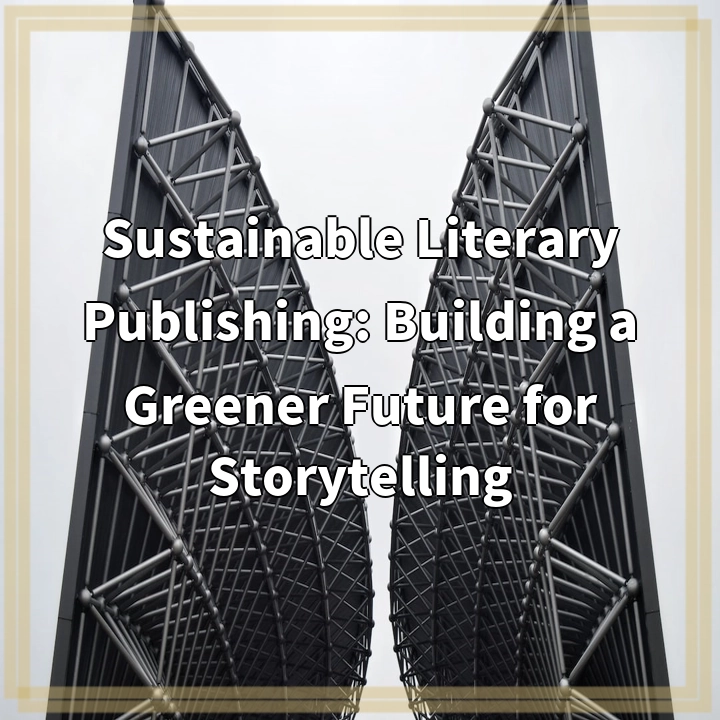
What is Sustainable Literary Publishing?
Sustainable literary publishing is an emerging concept that aims to integrate eco-friendly practices into the traditional publishing industry. It promotes environmentally conscious approaches to book production, distribution, and consumption, with the goal of reducing the ecological footprint associated with the creation and dissemination of literary works.
Real-World Problems Associated with Sustainable Literary Publishing
Sustainable literary publishing faces a range of challenges and obstacles that need to be addressed to create a greener future for storytelling. Here are some key issues:
1. Paper Sourcing and Forest Conservation
The publishing industry heavily relies on paper, which raises concerns about deforestation and habitat destruction. Unsustainable timber sourcing for paper production contributes to biodiversity loss and carbon emissions. Sustainable literary publishing aims to find alternatives to traditional wood-based paper and promote responsible paper sourcing practices.
2. Energy Consumption and Carbon Footprint
The energy-intensive processes involved in book production, printing, and distribution contribute to greenhouse gas emissions, exacerbating climate change. Sustainable literary publishing seeks to reduce energy consumption by exploring renewable energy sources, optimizing supply chains, and implementing energy-efficient practices throughout the publishing process.
3. Waste Generation and Recycling
The publishing industry generates significant waste, including unused books, promotional materials, and packaging. Proper waste management and recycling programs are essential to minimize the environmental impact. Sustainable literary publishing focuses on adopting circular economy principles, encouraging responsible book disposal, and exploring innovative recycling techniques for book components.
4. Digital Transition and E-Waste
The rise of digital publishing brought both opportunities and challenges for sustainability. While e-books have the potential to reduce paper consumption, they bring their own issues, such as e-waste from electronic devices and the energy required to power digital platforms. Sustainable literary publishing strives to find a balance between digital and physical formats while addressing e-waste concerns.
5. Supply Chain Transparency and Ethical Practices
Ensuring ethical practices within the publishing supply chain is crucial for sustainable literary publishing. This includes fair labor standards, responsible sourcing of materials, and transparent partnerships with printers, distributors, and retailers. Advocating for social responsibility throughout the industry can lead to a more sustainable and equitable publishing ecosystem.
By addressing these real-world problems, sustainable literary publishing can pave the way for a greener future, where the art of storytelling can flourish without compromising the health of our planet.

Solutions for Sustainable Literary Publishing
Sustainable literary publishing is a journey towards transforming the industry into a greener and more environmentally friendly realm. Here are some solutions that can address the real-world problems associated with sustainable literary publishing:
1. Sustainable Paper Sourcing
By adopting sustainable paper sourcing practices, publishers can choose recycled or FSC-certified paper options. Additionally, exploring alternative materials like agricultural residues or innovative plant-based fibers can reduce the reliance on traditional wood-based paper, preserving forests and biodiversity.
2. Energy Efficiency and Renewable Energy
Publishers can transition to energy-efficient technologies in printing and distribution facilities. Investing in renewable energy sources, such as solar or wind power, for operations and utilizing energy management systems can significantly reduce carbon emissions and minimize the environmental impact.
3. Circular Economy and Waste Reduction
Embracing a circular economy model involves considering the entire lifecycle of books, from production to disposal. Publishers can prioritize waste reduction strategies, such as minimizing overprinting, promoting book sharing and exchange programs, and implementing efficient recycling systems for book components.
4. Balancing Digital and Physical Formats
Finding the right balance between digital and physical formats can help reduce paper consumption and e-waste. Publishers can encourage the use of e-books and audiobooks, while also incorporating sustainable practices into digital platforms, such as optimizing servers for energy efficiency and supporting e-waste recycling initiatives.
5. Ethical and Transparent Supply Chains
Improving supply chain transparency and promoting ethical practices is critical to building a sustainable publishing industry. Publishers can actively engage with suppliers, printers, distributors, and retailers who prioritize social responsibility, fair labor standards, and environmentally conscious practices.
Through these solutions, sustainable literary publishing can bring about positive environmental change, creating a future where storytelling coexists harmoniously with the well-being of our planet.















